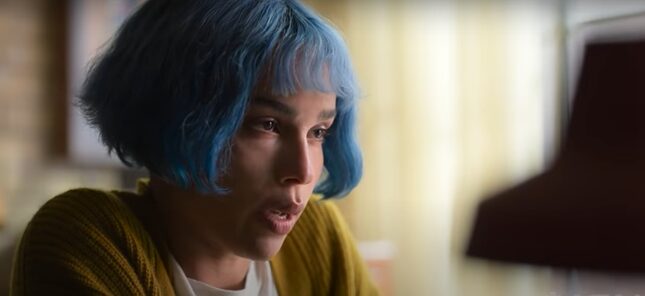Kimi Left Me Wanting More for Zoe Kravitz
Steven Soderberg's latest film prompted dozens of questions about relationships, how best to share secret intel, and nail guns.
EntertainmentMovies

I know what you’re thinking: Suppose we had highly classified information incriminating the CEO of the tech company we worked for, and that same company sent assassins to kill us. Would we use a nail gun to blast their asses after they broke into our giant loft apartment? Yes, yes, we would.
But that’s not the only question that arose for me after watching Steven Soderberg’s latest film Kimi— a film that left me head-cocked to the side at the ending, wanting so desperately for it to be recast and adapted into a Sci-Fi channel mini-series. The trailer for Kimi, littered with heart-racing montages, led me to believe this would be a blend of HER, The Circle, and Lady in the Window. Instead, it made the argument that “devices will be the death of us, but what if our devices save us from death?”— which is not first time I’ve heard this idea, but it also deserved more nuance and refinement. We get it, Soderberg, but since women far too often find themselves in situations where they have incriminating information about men in positions of power, I had a lot of questions.
Angela is smart. Why would she give her job the evidence?
Kimi tells the story of Angela Childs, played by Zoë Kravitz, who works as a commuter analyst for an Amazon-eque company during what appears to be a functioning covid society. Angela, who has crippling agoraphobia and OCD, cures her solitude by interacting with a band of virtual friends and biding her time by spying on neighbors with massive windows. From her vantage point, we see the random white guy with binoculars, her FWB Terry (who she texts on the reg) and the amenable contractor upstairs.
Angela lives a structured life. Before clocking in from home, she completes a series of regimented daily tasks; pushing herself to exhaustion on the treadmill, showering her skin raw, throwing back meds, eating simple petite meals, straightening her bed military-style, and repeatedly applying hand sanitizer. Angela’s trusted friend and employer is Kimi, the film’s Alexa equivalent, which solves problems and gives her answers to burning questions. Angela’s job is to make Kimi as user-friendly and human-like as possible, resolving glitches and bugs for quality assurance. The unexpected happens when Angela overhears what she thinks is a woman, Samantha (Erika Chistensen) being assaulted on a Kimi recording.
-

-

-

-

-

-

-

-

-

-

-

-

-

-

-

-

-

-

-

-

-

-

-

-

-

-

-

-

-

-

-

-

-

-

-

-

-

-

-

-








































